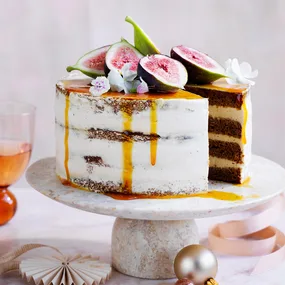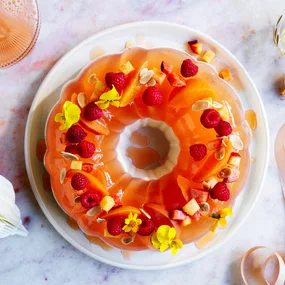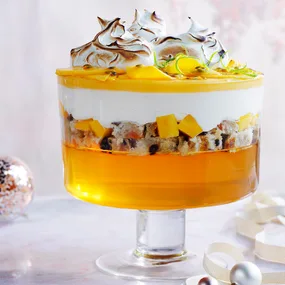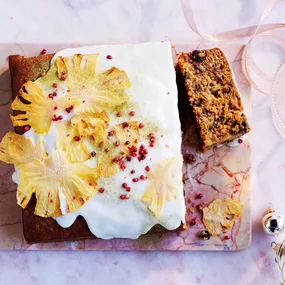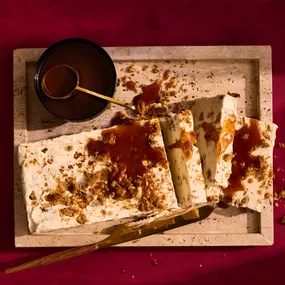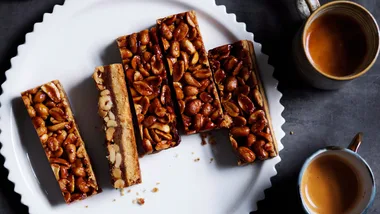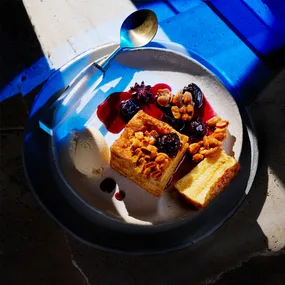Pâtissier Adriano Zumbo has made a name for himself with macarons. Now you can learn all the wacky-flavoured secrets of his sweet trade with the release of Zumbarons.
The macaron man is a hunted man. Pinning down Adriano Zumbo for an interview is quite the ordeal. He’s perpetually busy, and we’re allotted just a brief slice of time while he’s in the back of a cab on his way to the airport, bound for Melbourne’s Fine Food Australia festival. He’s a jet-setting celebrity chef in the purest sense – thanks in part to an acute skill with almond meal and eggwhites, but mostly to a far-reaching imagination, and also to a few stints on MasterChef.
Zumbo spent his teenage years sneaking lollies from his parents’ supermarket in the New South Wales country town of Coonamble, then trained in pâtisseries in France and Australia before opening his first store in Balmain in 2007. His intricate, wildly inventive sweet creations bought him almost instant acclaim, but “it was that break on TV that really changed things,” he says. “Before then, the secrets of baking and pastry had always been hidden, but now it’s all out in the open.” MasterChef helped create a demand for written recipes and information from the cooking pros, and this demand propelled Zumbo to write Zumbarons: A Fantasy Land of Macarons, a cookbook packed with recipes for his extreme Willy Wonka-esque macarons.
Macarons have incited a cultish buzz in recent years. What is it about these candy-coloured biscuits that has the world on such a sugar high? According to Zumbo, the reasons are many: “They’re so beautiful, they’re cute and they’re colourful. It’s their size too – you can eat a few of them. They have a great texture: soft and dry, chewy on the inside, crisp on the outside. And they’re the perfect present.”
Zumbo has often cited French pastry chef Pierre Hermé as an influence; the penny dropped when one of Zumbo’s former bosses gave him a box of delicate Hermé macarons to taste. “Hermé was the first to try different flavours, like balsamic and truffle oil,” Zumbo says. “He changed the world of pastry.”
How does Zumbo rate his own macarons against those of the acclaimed Parisian pâtisserie Ladurée, which recently opened a Sydney store? “We’re different,” he says emphatically. “I don’t think Ladurée is going to do doughnut macarons.” He’s probably right.
Before the release of Zumbarons, fans had to wait for Zumbaron Day to get their fix of unusual flavours in macaron form. At this annual frenzy (this year’s was on 6 October), customers queued around the block to buy any of the 60 flavours made specially for the occasion. The stores in Balmain, Manly, and Pyrmont and the café in Rozelle could scarcely keep up with demand. “People want the experience,” says Zumbo. “We try to be pretty out-there just for that one day, but it’s not viable to do all the time. You wouldn’t want to wake up every day and go buy a fried-chicken macaron.”
But then again, maybe you would. Or perhaps you’d prefer a macaron of wasabi and pickled ginger. Or strawberry bubblegum. Or chocolate mayonnaise. And now that these recipes have been printed in Zumbarons, anyone can make a batch of beetroot-raspberry or satay macarons at home.
Zumbo’s number-one tip for aspiring macaron makers is to be gentle with the meringue. “A lot of people just turn the mixer up to full speed, whisk the eggwhites until they’re fluffy and then chuck all the sugar in – there’s no care,” he says. “Eggwhites are so fragile; in two seconds they can just collapse. An Italian meringue is the best method to use, because the sugar syrup cooks the eggwhites, which makes them more stable, and they form a skin a lot quicker, so you don’t have to let them rest so long before baking them. The French method is a lot harder – not impossible, but a lot harder to get right.”
Is this the peak of the macaron mountain for Zumbo? “I don’t feel like I’ve conquered the macaron yet,” he says. “There’s always more to do. Everyone is making them, so the competition is becoming a lot harder, so we just keep trying to improve on what we already have. They’re a huge part of our business. I’d love to make more chocolates and ice-cream, but macarons are what people want. They love them. I don’t think they will ever fade away.”
Ingredients
Method
Main
Note All the macarons in Zumbarons use an Italian meringue mixture as their base. You’ll need to begin this recipe a day ahead. Food colouring brands vary – some gels require only 2 or 3 drops to give the desired colour, while some liquids require far more. Getting the colour right comes down to practice – you need to see how the colour looks in the syrup and then how that changes when it combines with the other ingredients. Powdered eggwhite is available at specialty food shops. Silpats are non-stick baking mats made of fibreglass and silicone; they’re available from specialty kitchenware shops and online.
Zumbarons: A Fantasy Land of Macarons by Adriano Zumbo, with photography by Cath Muscat, is published by Murdoch Books ($24.99, hbk). The recipe here has been reproduced with minor GT style changes.
Notes

